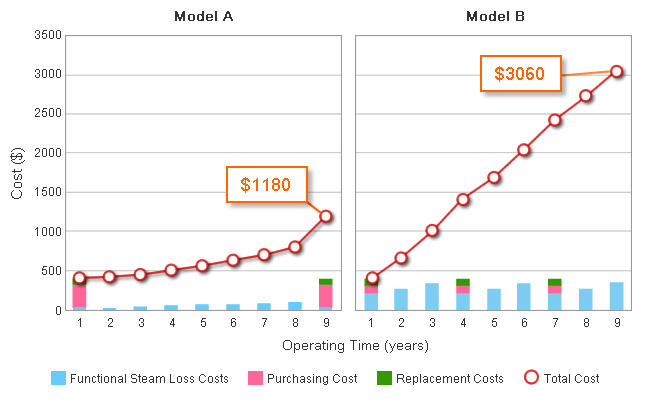Steam Bulletin
No. 61

Steam Bulletin
Steam Trap Selection Tips
Steam Bulletin is TLV's free bimonthly email magazine on steam systems, energy efficiency, product selection, and more.

If you depend on steam as part of your system, then selecting the right steam trap is essential. In this edition of the Steam Bulletin, we would like to introduce a few tips that are crucial when it comes to selecting the best steam traps for your system.
Of course, it is important to consider factors like capacity, operating pressure and temperature, but there are several other factors that you should also take into account, such as the type of application for which the steam trap will be used, the safety factor, and the long-term cost.
Different types of steam traps
There are many types of steam traps available on the market today and each type has its own benefits and drawbacks, so here is a refresher on the three major types of traps.
- Mechanical Traps: Mechanical traps use a float or ball mechanism to control when steam is released from the system based on the differences between steam and condensate density.
- Thermostatic Traps: Thermostatic traps use a temperature-sensing element to automatically open or close based on temperature differences between steam and condensate.
- Thermodynamic Traps: Thermodynamic traps use a disk and seat arrangement to open the trap based on the differences in properties between steam and condensate.
Selecting the right steam trap for you
Here are some important factors you should consider when making your selection:
Application:
When selecting a steam trap, the application it will be used for is crucial in determining the best type of trap. For steam distribution piping, the main purpose is to remove condensate and incondensable gases from the steam line whilst retaining steam.
Steam-using equipment requires a trap that continuously discharges condensate to prevent pooling and uneven heating, depending on the system design and back pressure, a combined steam trap and pump may be required.
Tracing lines trap selection depends on what temperature the traced line requires to be held at. High and low temperatures can be accommodated and special in line cleaning versions can be used on copper lines.
Safety Factor:
The safety factor is a coefficient used to select the correct discharge capacity for steam traps, providing a buffer zone for when condensate volume exceeds expected values. It ranges from 1.5 to 5 and factors like peak condensate loads and start-ups should also be considered when calculating safety factor. Always multiply estimated load by safety factor to ensure proper operation over time.
Life Cycle Cost:
When selecting a steam trap, consider not only the initial cost but also maintenance and operational costs. Factors like reliability and service life can affect overall costs in the long term. Rapid wear can lead to increased steam leakage and costly replacements. Consider all costs to make an economical decision.

We hope these tips have been helpful in helping you select the best steam trap for your needs! It is important to weigh the pros and cons of each type of trap and consider the specific needs of your application to ensure you select the best option for your system. If you have any additional questions about steam trap selection, please don't hesitate to contact our steam specialists!
News
TLV Expands to New Zealand with Grand Opening of New Office
It's an exciting time for TLV as we officially open the doors to our new office in the beautiful Art Deco city of Napier, New Zealand on Friday, 31st of March joined by the Member of Parliament for Napier, Honn Stuart Nash MP.
We are thrilled to announce this milestone in bringing our steam solution expertise to New Zealand. The new office will serve as the hub for our operations in New Zealand, enabling us to develop strong, lasting relationships with steam users around the country and provide them with the best steam solutions available.
Home to our team of steam specialists with decades of experience in the steam industry, this new hub will allow them to offer comprehensive consultations, services, customised solutions and technical support, catered to users' needs.
We look forward to assisting you!
TLV New Zealand Team
Product Focus
PowerDyne® Disc-Type Steam Traps

The TLV PowerDyne series steam traps are designed to improve performance and extend service life in steam mains and tracers, minimizing the disc trap life cycle cost. These thermodynamic disc traps are valued for their compact size, versatility, and wide pressure range.
The PowerDyne range offers models of traps that cover the complete range of pressures used in the industrial world.
The PowerDyne also incorporates several features to put it ahead of the competition:
- Long Service Life: Equipped with an air-insulated jacket that provides resistance to environmental effects and minimizes unnecessary operation and steam loss.
- Energy Conservation: Mirror-polished sealing surfaces that eliminates air binding and results in a tight seal that saves steam and reduces surface wear and steam leakage.
- Increased Productivity: Bimetal air vent ring quickly and efficiently vents start-up air without binding, which helps to reach full operating efficiency and eliminates the need for manual blowdown, reducing start-up time.
- Easy Maintenance: A replaceable module design that allows for quick and easy inline replacement of normal wear parts, without having to replace the entire trap, which reduces maintenance costs and downtime.
Product availability and delivery times vary by region.
Contact your local TLV representative for details.
We hope you enjoyed this edition of Steam Bulletin.
If you need assistance with selecting steam traps, TLV can help. Contact our steam specialist staff to apply for a plant survey and/or consultation session.
Finally, make sure to follow TLV on LinkedIn, Facebook or Twitter for more regular news and updates, and our YouTube channel for video content.
Best regards,
TLV